La solution miracle pour le marketing des startups

Ehaque jour, je vois des entrepreneurs et des spécialistes du marketing de startups qui cherchent désespérément un tour de magie.
Une sorte de tactique secrète ou de piratage qui fera pleuvoir l'argent sur eux en un rien de temps. Comme les codes de triche de votre jeu vidéo préféré.

Vous savez, comme toutes les autres startups autour d'elles.
One little trick and BOOM 💥 — explosive growth as far as the human eye can see.
Why can’t we have that? 🙄
Growth hacks they call them. The internet’s version of black magic.
Chances are you’ve been on a quest to find the secret for a while now 😯.
Chances are you’re looking for such a secret at this very moment 😏.
Chances are you’ve already given up on ever finding the secret 😒.
Chances are you stopped believing the secret existed in the first place 🤔.
Chances are you’re reading this post because the title hints at the secret 😛.
 Est-ce que je te trolle ? 🤡
Est-ce que je te trolle ? 🤡
No. I’m a man of my word. I will show you the secret.
Car oui, le secret existe.
But it’s not guarded by one of those growth hacking agencies that keeps on telling you that they’ll launch your startup into the stratosphere 🚀.
If only you would give them a shot.
👉 In exchange for about half your funding 💸 .
They’re not guarding anything. They just want you to believe that you know nothing and they know everything so you’ll give them their money.
Au pays des aveugles, le borgne est roi, vous vous souvenez ? C'est ce qu'on appelle le marketing.

Don’t get me wrong.
Growth hacking is fun. It’s a great way to cut corners and get ahead of the competition 🏎️. You’ll win some ground and maybe, just maybe it’ll even get you some initial traction.
Mais cela ne vous mènera pas plus loin que votre adéquation produit-marché ne vous le permet.
True product-market fit is the one and only way to scale and growth hacking doesn’t hold the secret to getting you that.
Le secret réside en vous 🗝️.
As a startup, you’re in the business of solving real-world problems.
You have a unique take on your topic’s problems. You have a unique set of tactics, strategies and approaches to solve those problems.
You have unique value to give ✨. Product — and content-wise.
Quelque part, il y a un groupe de personnes qui ont exactement les mêmes problèmes que vous êtes en mesure de résoudre. Un groupe de personnes qui a besoin de votre valeur. Votre public.
👉 You just need to find that group of people — or have ‘m find you — and give ‘m what they need.
That’s it. That’s your secret 🗝️.
🎈 Giving out your value to the people it’s of value to.
Here’s the thing startups don’t seem to get 👇.
People won’t buy your product because you’ve been working your ass off for four straight years, living off a waiter’s salary, sleeping on a stinking mattress in your friend’s garage.
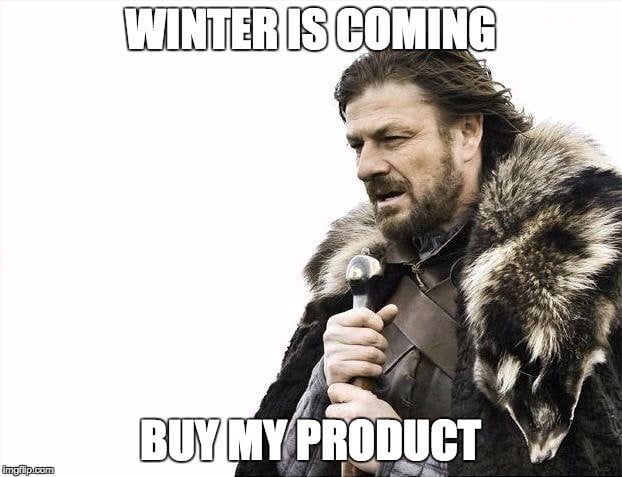
Les gens achèteront votre produit parce que cela améliore leur vie.
Vous vous demandez pourquoi personne ne lit vos articles de blog ?
Pourquoi seule ta mère aime tes mises à jour sur Facebook ?
Why you’re getting so much hate on your cold emails?
Why your website traffic isn’t going up?
Pourquoi aucun des utilisateurs de votre version d'essai ne commence à payer ?
Here’s why 👉 Tout le monde s'en fiche.
Le fait de mettre votre sang, votre sueur et vos larmes dans votre produit ne les rend pas redevables de quoi que ce soit. Cela vaut pour la vie en général.
Êtes-vous en train de me dire que je devrais me concentrer sur le produit et oublier le marketing ? 🤔
Non.
I’m telling you to find the people in need of the value you can give them.
I’m telling you to build a strategy around helping people.
I’m telling you to mettre le marketing au premier plan parce qu'elle améliorera à la fois votre produit et votre marketing. En outre, les plus facile.
Mieux encore : I’m telling you to put customers first.
TL;DR
- le growth hacking est amusant
- but it won’t sustainably grow your startup
- seule une véritable adéquation produit-marché.
- le secret de la croissance repose sur vous
- give out value to people it’s of value to
- les gens achètent votre produit parce qu'il améliore leur vie.
- construire une stratégie autour de l'aide aux personnes.
- mettre le marketing au premier plan.
- mieux encore : les clients d'abord
9 out of 10 startups fall flat on their faces 🤕
You don’t find customers for your products.
You find products for your customers.
La plupart des start-ups sont fondées sur des idées. Quelqu'un a une idée géniale et les responsables du marketing doivent trouver un moyen de faire payer les gens pour cela.
I get that 👍.
It’s way easier to build a product than to build an audience for it.
You have to talk to a lot less people. There’s nobody to tell you your epic idea is actually shit and your mom is proud of you because you’re chasing your dreams 💭.
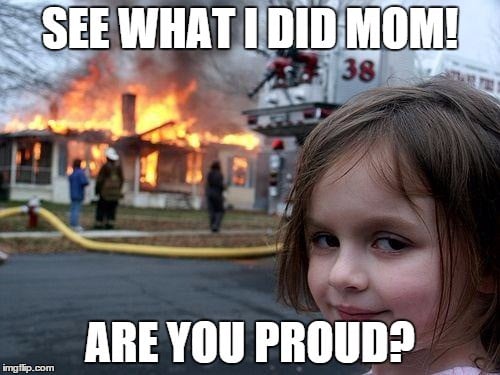
But here’s the thing.
Entrepreneurship is not about you and it’s not about your ‘epic’ idea.
It’s about making people’s lives better. It’s about helping and giving value 💝.
You know what’s even more difficult than building an audience?
Construire un produit avec et pour un public.
👉 Un produit qui apporte de la valeur aux gens. Un produit que les gens soins à propos de 💕.
If people don’t care about your product, reality will catch up with you. Your world will come crashing down. All of your energy, time and money will have been for nothing.
And there’s nothing your mom can do about it 🤷.
9 start-ups sur 10 échouent 💀.
Principale cause de décès ?
Trying to build a product for a group of people that doesn’t exist.

TL;DR
- les gens construisent d'abord des produits, puis un public.
- but what if people then don’t care about your product?
- le renverser
- constituer d'abord un public, puis le produit pour ce public.
- ou finir par mourir comme le font 9 startups sur 10.
Mediocre Viable Product 😕
En 2011, Eric Ries a pris d'assaut le monde des startups avec The Lean Startup.
People hailed it as the Bible of Startups 🙏.
Rightly so. The idea of starting from something small and gradually building it on customer input is probably the quickest way for a startup to find product-market fit 🖇️ and a scalable business model 📈.
If you haven’t read the Lean Startup (you should), here’s the gist of it:
- Build a Minimum Viable Product (MVP) 🎁
- Find out if people will pay money for it 💁
- Use feedback from those people to adapt the MVP up until the point a sustainable group of people will buy it 💰
An MVP is a product that has the minimum set of features to prove the hypothesis that is essential to your idea’s potential to exist.
(Just so we’re straight on that.)
Aujourd'hui.
Remember the Product Adoption Curve? 😏

It’s one of those gazillion frameworks they show you in marketing class you instantly forget about. I did anyway 🤷.
The Product Adoption Curve is something all new kids on the block have to go through. Facebook, Slack, Uber and DVDs (still ring a bell? 🔔) — heck, even underwear at some point must have gone through it (hope those do ring a bell…).
Your MVP is meant to win over the innovators and, while you’re at it, the early adopters. The more the merrier, right? 🙌
Innovators and early adopters are the guys that’ll take your product for a spin when it’s still in diapers 👶.
They‘re okay with it still shitting the bed from time to time 💩. They look beyond the bugs and spartan features to see if your product deserves to exist.
They’ll share their findings with the world and, if they like what they see, may end up evangelising your product 😇.
Mais que se passe-t-il si votre MVP est nul ? 🙃
What if your MVP is so bad the innovators you’re trying to seduce don’t even give it the light of day?
Sure, it’s the bare minimum of your product, but you should still get some traction out of it, right? 🤔
It only takes one to start a fire 🔥 but it takes many to keep the fire burning.
Les MVP ont pour but d'allumer la flamme de la startup mais finissent souvent par le tuer 💦.
In the early days your startup needs a bunch of passionate, almost religious fans 🙏. People that really dig what you’re doing and are in it for the long haul.
Vous avez besoin de ces fans pour vous aider à franchir le chasm, le grand fossé qui vous sépare des masses qui vous permettront de devenir une vraie entreprise.
🙃 Without fans you’ll be stuck at the start and fall into the chasm.
And once you’re in that shithole… Well, good luck getting out again 😐.
Eric Ries s'est-il trompé ? 🤔
Pas vraiment. L'idée de créer une première version allégée de votre produit et de la développer ensuite avec vos clients est une chose à laquelle je crois toujours fermement. Pas seulement dans les premiers temps et pas seulement pour les startups.
Entrepreneurs just seem to think the minimal in MVP gives them a hall pas to create whatever flaky fantasy they have in their heads and get away with it. No matter how crappy it is 💩.
L'arrogance est-elle à blâmer ici ou est-ce parce qu'un célèbre entrepreneur a dit un jour :
It’s not the consumers’ job to know what they want.
💬 Steve Jobs
Voici l'un des textes les plus mal interprétés de tous les temps.
Not as bad as some people getting “kill all the people” from love-preaching religious books, but close.
La plupart des entrepreneurs semblent penser que cela signifie qu'ils doivent décider quels produits les clients doivent utiliser.
What Steve really meant is that, as an entrepreneur, it’s your job to know which products customers will want to use without them telling you.
Oui, je sais. Steve nous a bien aidés 🙄.
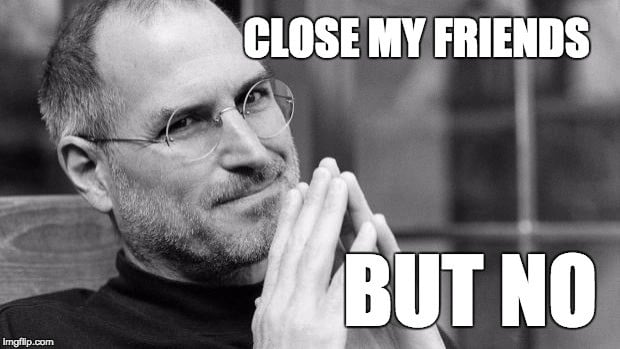
Il faut savoir ce que les clients voudront utiliser :
- intelligence 💡
- empathy 👂
💭 9 entrepreneurs sur 10 sont-ils stupides ou n'écoutent-ils tout simplement pas ?
Trop de startups ne parviennent pas à attirer les premiers adeptes dont elles ont tant besoin. Elles s'efforcent d'être remarquables, mais finissent par se distinguer par leur médiocrité.
⚠️ You don’t get away with mediocrity.
Your customers deserve better. The world deserves better.
TL;DR
- l'approche allégée est la meilleure façon de trouver l'adéquation produit-marché
- et un modèle d'entreprise évolutif.
- votre MVP est destiné à séduire les premiers utilisateurs et à franchir le gouffre.
- mais les MVP deviennent souvent médiocres.
- because entrepreneurs don’t listen to what the market is telling them
- et ne parviennent pas à franchir le gouffre.
Customer validation kinda sucks 🤔
The lean approach was brought into the world so startups could nail product-market fit asap. And yet the lion’s share is still fucking it up.
What’s missing here? 🤔
Les entrepreneurs ne parviennent pas à comprendre ce que veut le client.
Quelle est la seule chose qui vous aidera à mieux comprendre un marché ?
🥁…🥁…🥁
Market research 🤓.
Ce n'est probablement pas le feu d'artifice auquel vous vous attendiez.
Je parle de l'étude de marché de 2017.
Not surveys. Stay away from surveys 👎.
Didn’t we just agree that Steve wants you to figure out what your customers want without them telling you?
Let me break down real quick why surveys suck for customer validation 🙅:
- 💣 Surveys are faceless. Customer development is about understanding people’s pains and needs. There’s no way they can tell you about those by ticking off some checkboxes.
- 💣 Surveys only tackle what’s already on your mind. You think your idea is epic and you’ll design your survey to see that confirmed. These presumptions will make you miss out on a lot of insights customers can give you. And are you so sure you know the right questions to ask?

- 💣 Surveys lack context. Do you know who you’re talking to? Segmentation is critical. How do you know if it’s good or bad that 20% confirmed your idea if you have no tangible idea of who they are and what makes them tick?
- 💣 Surveys don’t allow for proper follow-up. The whole idea of customer development in the lean approach revolves around finding paying customers for your MVP. Surveys don’t give you the opportunity to build relationships with potential customers.
Individuals are honest only to the extent that suits them, including their desire to please others.
💬 Dan Ariely in ‘Predictably Irrational’
- 💣 Surveys don’t predict future buying behaviour. Surveys measure rational motives, but human decision-making is determined by a lot of factors, a lot of which are not conscious or rational. People think they act out of ratio, while in fact they often just rationalise actions they did for reasons they can’t articulate. So even if people say they will buy your product on your survey, doesn’t mean they actually will. If you’d like to dive deeper into this, check out Thinking Fast & Slow by Daniel Kahneman and Predictably Irrational by Dan Ariely.
En fait, la validation du client dans le Lean Startup semble être plutôt un concept abstrait.
Joel Gascoigne de l'outil de gestion des médias sociaux Buffer a validé son idée par “simply tweeting the link and asking people what they thought of the idea.”
He then goes on saying 💬:
I got some useful feedback via email and Twitter, I considered it “validated”. In the words of Eric Ries, I had my first “validated learning” about customers.
Vraiment ? 🙄
Some buddies of yours cheer you on and — hallelujah — the idea is validated?
Bien sûr, Buffer s'est avéré être un excellent produit pour lequel de nombreuses personnes sont prêtes à payer, mais on peut difficilement appeler cela une technique de validation.
The Lean Startup dictates you should validate your idea as quickly as possible and then build from there. But what is validation, really? 🤷
People saying something is a good idea doesn’t mean it is and it sure as hell doesn’t mean they’ll buy it.
But if you’re all psyched about your amazing idea, you’ll settle for that and start building. Of course you will 😉.
And that’s how you get Mediocre Viable Products that don’t take off.
👉 Le suicide d'une startup.

Or how about this 👇.
That is as sweet as honey 🍯.
But does it mean your idea sucks if you don’t get that? 😐
Not every idea is going to go viral. There’s also a big difference between someone giving you their email address and someone giving you money.

La question est la suivante :
La validation du client telle qu'elle est prescrite dans le Lean Startup est pour le moins sommaire. Une mauvaise validation conduit à des MVP défectueux qui ne parviennent pas à s'imposer.
Qui sait combien de produits géniaux n'ont jamais vu le jour à cause d'une version minimale viable minable construite sur la base d'une validation minable de la part des clients ? Ou l'inverse ?
You’re just not listening. You’re drunk in love with your baby-girl/boy idea and are looking everywhere for signs you should pursue it.
You’re just seeing whatever you want to see 😍.
Il s'agit de cas de biais cognitifs, plus particulièrement biais de confirmation et erreur d'excès de confiance.
It’s okay that you have that. Everyone does. It’s how your brain works and inherently human. The only way to cope with these blindspots, is to acknowledge you have ‘m and work your way around.
Oh, and if you’re one of those “yeah, yeah but I’m different” — kind of people, you’ve already lost.

TL;DR
- les entrepreneurs sont incapables de comprendre ce que veut le client
- they’re missing market insights
- la validation par le client telle que prescrite par l'approche lean est merdique.
- les enquêtes, c'est nul
- toute idée devient virale
- email opt-ins don’t equal money
- une mauvaise validation conduit à des MVP défectueux qui ne parviennent pas à s'imposer.
- they’re prone to cognitive bias, clouding your vision
Minimum Viable Audience 👨👩👧👦
There’s a better way ☝️.
Au lieu de construire un produit pour un public potentiel, commencez à construire un public pour un produit potentiel.
Today’s Internet is the entrepreneurial gift from heaven for its ability to give you live insights in what the world in all its complexity is thinking and feeling at any time.
Les gens viendront directement vous parler de leurs problèmes, de leurs désirs et de leurs besoins sans que vous ne leur demandiez rien. Pour autant que vous preniez le temps de regarder 👀.
Real-time market research 🕵️. Eat that, surveys.
Utilisez les médias sociaux et les communautés Internet pour écouter avant de parler. Apprenez à connaître les personnes que vous ciblez afin de construire quelque chose qu'elles veulent vraiment et pour lequel elles sont prêtes à ouvrir leur porte-monnaie.

Find your audience — the people you can and want to help — and connect with them.
Soyez une mouche sur le mur, gardez vos yeux et vos oreilles ouverts. Ensuite, entrez et engagez-vous.
Interrogez-les sur leurs douleurs, découvrez les problèmes qui les préoccupent et cherchez à savoir ce dont ils ont besoin.
You’ll find this knowledge to be incredibly powerful.
Not only are these people discussing the exact problems you’re looking to leave your mark on, they’re also using the language typical for your niche.
Every conversation will make you more of an expert and increase your ability to create unique value 👨🔬.
Once you’ve immersed yourself in the tribe, its time to start building your influence by giving to the community.
Votre jeu consiste à donner de la valeur. Pas encore sous la forme d'un produit, mais sous la forme d'un contenu qui :
- helps 🤝
- inspires 💡
- delights 😊
- entertains 🤹.
Sans attendre rien en retour.
One of the key things we’re learning is that you need to build an audience before you build your product. Build your audience not for marketing, but for learning.
Fondateur QuickSprout et CrazyEgg
You’ll be learning directly from a real group of people as they react to relevant triggers — your content — instead of trying to garner a strained idea from generic market research based upon vague lean startup validation techniques.
These are real people who’ll pay attention to you, with real pains 🤕 you can solve and real goals 🥅 you can help them achieve 🏆.
The cues you’ll get from your audience bouncing back off your content will give you the ingredients to cook up a minimum viable product that is Exceptional (EVP) rather than Mediocre (MVP) and gets the early adopters all lyrical, ready to bring you across the chasm 😏.
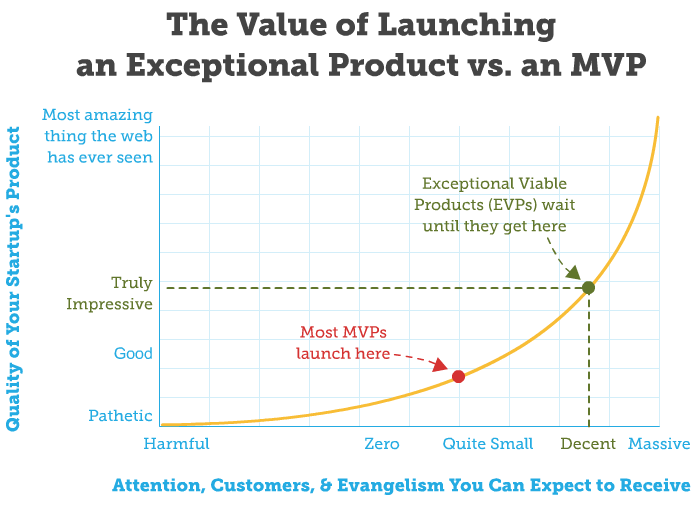
Even if your EVP doesn’t get the traction you hoped for, you’ll still have a loyal audience coming back because you’re feeding them value and helping them advancing in whatever it is they care about.
Vous pouvez leur montrer des wireframes, des diapositives, des pages d'atterrissage, mockups ou d'autres échantillons de produits à faible risque et voir comment ils réagissent.
If you can pull off building yourself an engaged audience, you’ll have a focus group that will do the heavy marketing lifting for you 💪.

La plupart des gens commencent par avoir quelque chose à vendre et doivent ensuite trouver comment le vendre et à qui le vendre.
With an audience, you’ll have your customers sitting in your backyard, waiting for your next big thing.
They’ll be your compass, able to get you back on track as soon as you go off the rails. If they’re suddenly responding less, it could mean you’ve lost touch and need to re-adjust your focus.

The beauty is that maintaining an audience requires minimal effort because it’s just about being human. You’re talking and listening. You’re connecting with other human beings, which is what both life and business are ultimately all about.
TL;DR
- au lieu de construire un produit pour un public potentiel.
- constituer un public pour un produit potentiel.
- les médias sociaux et les tribus Internet permettent de réaliser des études de marché en temps réel.
- trouver les personnes que vous pouvez et voulez aider.
- votre public vous dira ce qu'il veut payer.
- construire un EVP (Exceptional Viable Product) au lieu d'un MVP.
- maintenir une audience est facile.
- it’s talking, listening — and just being human
Why giving is your superpower 💫
You do have a magical superpower 👉 Generosity.
It also goes by the name of altruism. Or selflessness 💁.
🎁 Offrir de la valeur gratuitement.
Sounds a tad contradictory to the transactional nature of business? 🤔
Never in the history of the world has there been someone who has given away too much. It’s one of the things that sets apart des leaders et des suiveurs.
Most people just laugh when they hear that the secret to success is giving . . . Then again, most people are nowhere near as successful as they wish they were.
💬 Bob Burg and
John David Mann
‘The Go Giver: A Little Story About a Powerful Business Idea’
When you give away value so good you could have charged money for it, you show you’re in the business of helping people rather than helping yourself.
This is selfless goodwill — you give something without expecting anything in return. People will admire you for it.
Giving builds your ethos — the authority, credibility and honesty that comes with your message and is essential for persuasion.
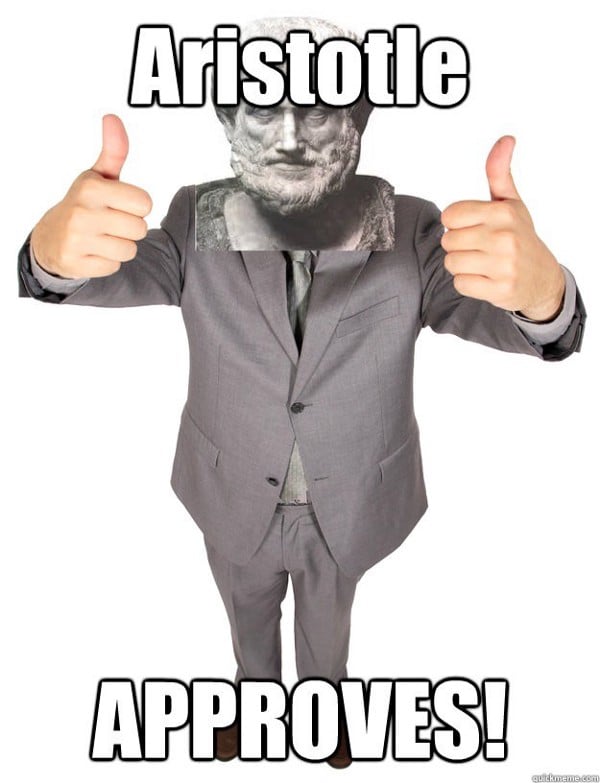
It’s how Aristotle and his old Greek friends rolled when they wiped the floor with their debate opponents in Athens.
Le don renforce votre capacité à influencer et donc à vendre.
✋ What’s more: humans are wired to repay generosity.
Try sending out a batch of Christmas cards to complete strangers 📬. You’ll be amazed by how many you’ll get back. From people you have never met.
Il s'agissait d'une véritable expérience sociale menée en 1976.
Philip Kunz et Michael Woolcott ont envoyé 578 cartes de Noël à de parfaits inconnus et en ont reçu 117 en retour.
Un taux de réponse de 20%. Les spécialistes du marketing tueraient pour cela de nos jours.
If you give people exceptional value regardless of whether they ever pay you a dime, they’ll feel a need to repay you one way or another.
By choosing you over a competitor, for example 😎.
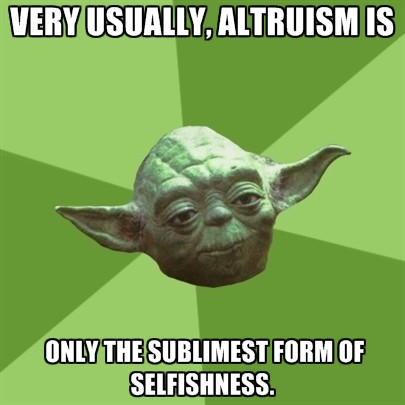
So. No cutting corners, no holding back, no being stingy.
👉 Help, inspire, delight & entertain.
Give. At every step of your prospect’s journey.
Blog posts, podcasts, videos, ebooks, whitepapers, webinars, online courses.
Whatever your audience likes best 👉 go all-in and make it high-quality.
- 🖐️ Giving allows you to connect with customers without pitching. They’ll lower their walls because they’ll know, like and trust you.
- 🖐️ Giving pulls people towards you. No desperate cries for attention needed, just magnetic superpowers.
- 🖐️ Giving will make you a trusted authority in your field.
There are two kinds of people: eaters and bakers. Eaters think the world is a zero-sum game: what someone else eats, they cannot eat. Bakers do not believe that the world is a zero-sum game because they can bake more and bigger pies. Everyone can eat more. People trust bakers and not eaters.
Les gens achètent et se réfèrent à des personnes qu'ils connaissent, qu'ils apprécient et en qui ils ont confiance.
C'est une vérité universelle.
It was true in Dale Carnegie’s time when he wrote the all-time bestseller How To Win Friends and Influence People and it’s true today.
Customers aren’t looking for a sales pitch.
They’re looking for solutions to their problems.
Give it to them and you’ll be their hero 🌟.
High-value content is a low-threshold way of helping your target group while learning where you can make a difference. It’ll help you build a loyal audience that trusts you to solve their problems.
The very best thing you can do as a startup founder is to earn a reputation for helping others.
If you help people advance in whatever they care about, they’ll respect you, they’ll trust you, they’ll engage with you, they’ll want your help, they’ll seek your opinion, they’ll share your content. And they’ll buy from you.
TL;DR
- la générosité/l'altruisme/le désintéressement est votre superpouvoir.
- donner de la valeur gratuitement.
- it’s one of the things that sets apart leaders from followers
- le don renforce votre capacité à influencer et donc à vendre.
- les gens ressentiront le besoin de vous rendre la pareille.
- les gens achètent et se réfèrent à des personnes qu'ils connaissent, qu'ils apprécient et en qui ils ont confiance.
- build your klt — factor with content that helps, inspires, delights and entertains
“I already have a product, dumbass” 🙃
You’re probably reading this because you’re looking to get some actionable advice on how to market your startup for maximum growth 📈.
Et me voilà en train de prêcher de prétendues sagesses sur la façon dont vous auriez dû jouer votre jeu marketing bien avant d'avoir un produit.
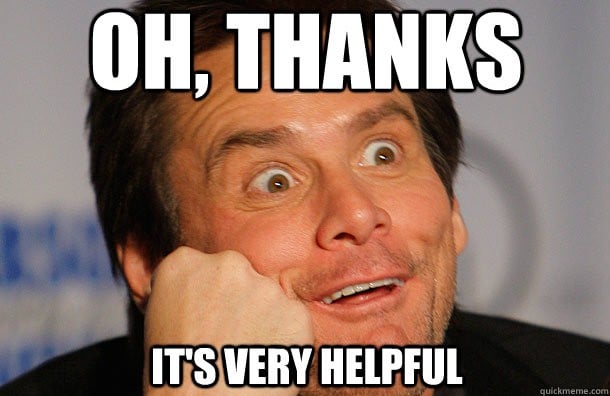
Ne bougez pas, les choses concrètes arrivent.
Ce petit texte original est la préface d'une série d'articles destinés à vous guider dans la jungle sauvage du marketing B2B en ligne.
Dans les prochaines semaines, je publierai des guides sur la façon de le tuer :
- Communautés Internet
- Courriel froid
- … and whatever I still come up with (feel free to pitch in my idea pool)
But this right here, this value-audience fit stuff, is your skeleton key 🗝️.
It’s the One Key To Rule Them All 👊.
All of the guides I’ll be writing, all of the actionable advice will be built on that one guiding principle of building yourself a fanbase by giving value to people that value is of value to.
Les canaux et plateformes tels que Facebook, LinkedIn, Google et le courrier électronique ne sont que des moyens que vous pouvez déployer pour transmettre votre valeur à votre public.
And here’s the thing.
⚠️** SPOILER ALERT: HERE’S WHERE IT BECOMES RELEVANT TO YOU**⚠️
Si les startups peuvent faire ce travail à partir de zéro, imaginez le potentiel si vous avez déjà une base de clients en place.
Mais une base de clients n'est pas un public encore.
❓ Ask yourself.
Qu'est-ce qui vous rend unique ? Quelle valeur apportez-vous ? Quel est votre domaine ? Qu'est-ce qui fait de vous un roi ? Qui aidez-vous ? A qui apportez-vous de la valeur ?
Pour qui écrivez-vous du contenu ? Pour qui construisez-vous votre produit ?
Can’t come up with an answer?
👍 Bon.
Now you know why no one is reading your blog posts.
Why only your mom likes your Facebook updates.
Why you’re getting so much hate on your cold emails.
Why your website traffic isn’t going up.
Why none of your trial users starts paying.
👉 Vous savez maintenant quel est le problème.
Arrêtez d'envoyer au hasard des courriels à froid à des gens qui vous demandent de l'attention.
Arrêtez de mettre en place un milliard de pages d'atterrissage pour voir ce qui colle.
Arrêtez de poster sans réfléchir sur Facebook, LinkedIn, Twitter et Instagram.
Arrêtez de jeter de l'argent dans le drain des publicités Facebook et des mots-clés Google.
Cessez de chercher des tours de magie et des victoires rapides.
✋ Partir de zéro.
Trouvez la zone de problèmes où vous pouvez être le roi des solutions, puis construisez un royaume de valeur.
Not sure if you’re so unique? 😯
Double-down on your topic until you’re an authority to be reckoned with on something you truly know and care about. Pursue your curiosity and you’ll find the path that’ll make you unique 🌟.
TL;DR
- Construire une base de fans en apportant de la valeur est la clé du marketing en ligne.
- d'autres actions sont à venir.
- en attendant:.
- qu'est-ce qui vous rend unique ?
- à qui donnez-vous de la valeur ? .
- arrêter de chercher des tours de magie et des victoires rapides.
- trouver où vous pouvez être roi et construire un royaume de valeur.
Lean from the best 👑
I didn’t invent this stuff.
I’m just the clown reporting it.
Cela a déjà été fait et bien fait.
Certaines des startups les plus prospères aujourd'hui ont bâti leurs royaumes sur la diffusion de contenus à forte valeur ajoutée plutôt que sur des gains rapides et des méthodes de croissance.
If you don’t take my word for it, take theirs.
1. Kissmetrics 📊
If you’ve been reading stuff on online marketing and startups, there’s no way you don’t know about Kissmetrics, marketing analytics software.
Founded by content marketing kings 🤴 Hiten Shah and 🤴 Neil Patel Kissmetrics started blogging around 2009. Long before their product was launched.
Pour ce faire, ils ont identifié leurs personas d'achat et créé du contenu qui les aide.
Today, about 9 million online marketers, founders, CTOs,… read their posts every month. L'ensemble de leur activité repose sur elle 🚀.
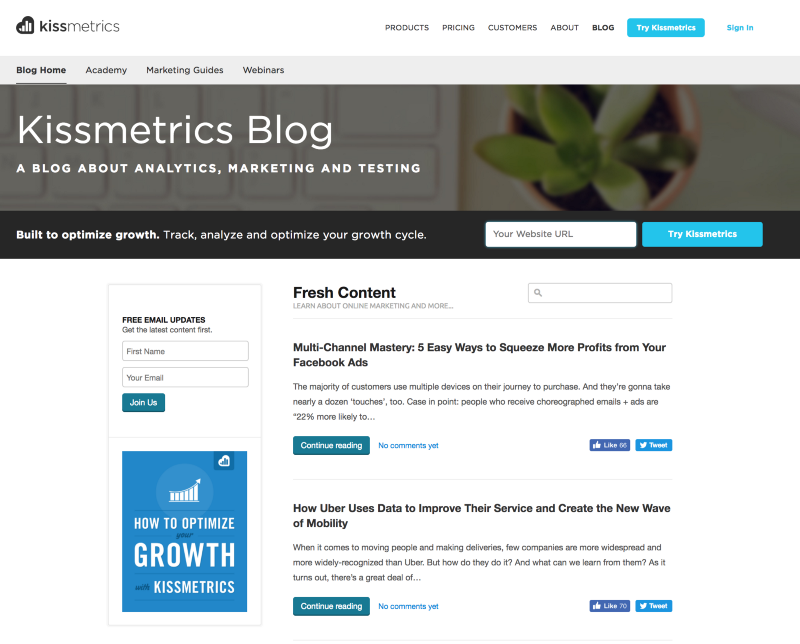
It shows you the unparalleled power of blogging to slow-cook an idea into a readers’ head.
I couldn’t see myself using anything else than Google Analytics. It’s easy, it’s good and it’s free. Why would I change? 🤔
But while making my way through startup marketing, I found myself regularly reading well-written posts over at Kissmetrics’ blog.
Not just stuff like ‘Key Customer Metrics You Need To Be Tracking’, but also How Search Rate Is Killing Your Conversion Rate (And How To Fix It) and Effective SEO For All Stages Of The Conversion Funnel.
On les trouve partout. Leur contenu vous aide réellement à développer votre entreprise. These guys must know what the hell they’re doing 😯.
Alors, à un moment donné, j'ai dépassé les bornes.
Today, I’m not only using Kissmetrics, I’m recommending it to other people.
Mise à jour: Malheureusement, Kissmetrics a été vendu et le blog a été mis hors ligne. Une partie du blog a été déplacée sur neilpatel.com, mais aucun des articles mentionnés ci-dessus n'est encore en ligne.
2. Chasse aux produits 😼
What cool products are you using?
It’s a question we all ask and it turned out to be one hell of a community builder: Product Hunt.
Product Hunt is the little baby of Ryan Hoover. Ryan is one of those guys who just friggin’ loves everything new and cool ✨.
Pas seulement pour le plaisir. Pour Ryan, les nouveaux produits sont une occasion d'apprendre et, surtout, un moyen d'entrer en contact avec des personnes partageant les mêmes idées.

Pour savoir s'il pouvait créer une communauté autour de ce thème, Ryan Hoover a commencé par publier une lettre d'information électronique présentant chaque jour les meilleurs nouveaux produits.
Within two weeks, Ryan’s little mailing list had 170 subscribers geeking over new products discovered by 30 hand-picked contributors, among which startup founders, VCs, and prominent bloggers.
Today, Product Hunt is Silicon Valley’s favourite little playground. A tightly-knit community of like-minded geeks who bond over anything hot 🔥 and the new ✨. Tech, but also books, podcasts and games — you name it.
3. Moz 🔍
Here’s what Rand Fishkin, founder of SEO software Moz, has currently pinned on his Twitter wall.
Vous voyez ce que je veux dire ? 😎

Comme Kissmetrics, Moz a été créé sur la base d'un blog, qui s'appelle un blog.
For the first 18 months, they built an audience with little free tools and downright legendary SEO for beginners guides 📚.
These guides have been around for more than 12 years now. They’re being continuously updated and are still pulling in new customers every day.
Au moment où ils ont lancé leurs abonnements en 2007, Moz disposait d'une audience d'environ 10 000 spécialistes du marketing qu'ils utilisaient pour affiner et accroître leur valeur.
By 2008–2009, Moz was pulling in subscribers from far beyond their own community. Today it is one of the leaders in SEO software.
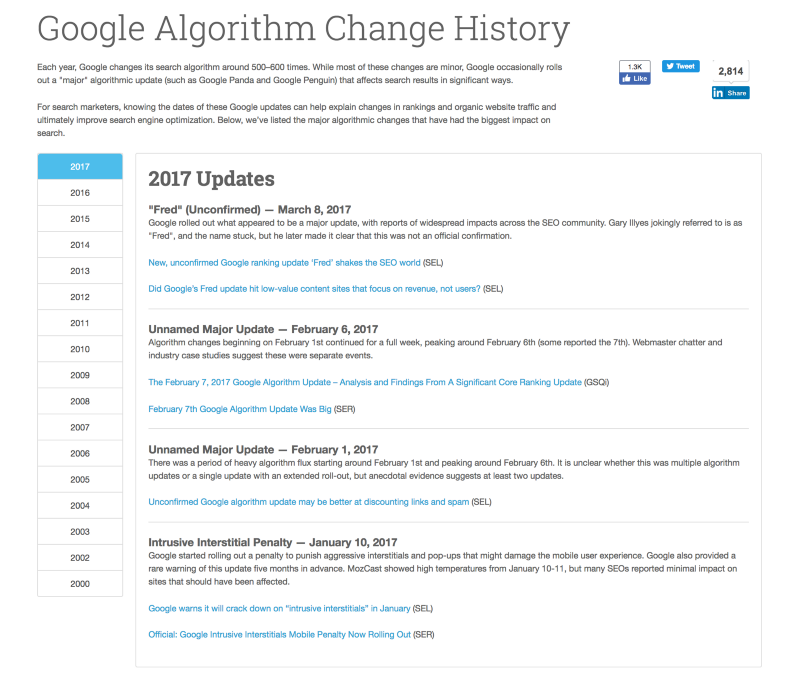
Moz is also known for staying right on top of its industry with thorough research. They’re famous for annually documenting changes in Google’s algorithm and teaching on how to go about those changes. It’s a unique resource that gives them invaluable thought leadership 💭.
Without that “marketing first” approach, I’m skeptical if we ever could have gotten a product off the ground.
💬 Rand Fishkin — Founder of Moz
Rand a poursuivi ses convictions en matière de création de communautés dans le cadre du marketing en s'associant à HubSpot pour créer Inbound.org, une communauté pour les spécialistes du marketing en ligne.
4. HubSpot 🎯
HubSpot est un empire du marketing fondé sur des valeurs de toutes sortes.
Entre autres choses, ces personnes sont des champions en matière de marketing de projets secondaires. Ils construisent de petits outils gratuits qui apportent une grande valeur à un grand nombre de personnes.
L'exemple le plus célèbre est WebsiteGrader, un outil qui vous indique l'état de votre site web pour des paramètres clés tels que la performance, l'aptitude à la mobilité, le référencement et la sécurité. Gratuitement.
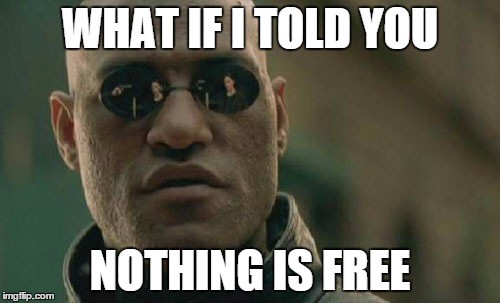
It goes without saying HubSpot’s software offers you the solutions to pain points that may emerge from WebsiteGrader. They’ll make sure you know about that with drip email campaigns 💦 and quality content 📚.
HubSpot is big on content. They have a whole library of free ebooks on inbound marketing topics. They complement those with checklists 📋 and templates 📝 to get their audience to really act on those guides and push them further down the sales funnel.
The Next Big Thing… 💯
Now that you’re all hot and ready to get cracking on that audience…🔥
I’ll have you wait for a week to show you how to go about that 😛.
💬 We’ll talk about:
- how to find a field where you be of value in 🤴
- how to find your audience where you can be of value to 👨👩👧👦
- how to make sure the things fit together like they were meant for each other, forever and ever 💏
Make sure to subscribe so you don’t miss anything 😏.

Nous espérons que vous avez apprécié cet article.
If you did, hit ❤ to spread the word!
For more hot stuff on startups, growth marketing and sales
👉 s'inscrire ici
👉 suivre @salesflare sur Twitter
- Les 20 meilleurs livres de vente qu'Elon Musk est probablement en train de lire - 14 février 2023.
- 6 méthodes infaillibles pour que votre entreprise obtienne ses 100 premiers clients - 6 décembre 2022
- Comment construire un entonnoir de vente qui se vend - 2 septembre 2021
